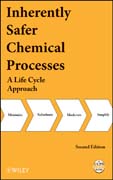
Inherently safer chemical processes: a life cycle approach
Inherently Safer Chemical Processes presents a holistic approach to making the development, manufacture, and use of chemicals safer. It discusses strategies for substituting more benign chemicals at the development stage, minimizing risk in the transportation of chemicals, using safer processing methods at themanufacturing stage, and decommissioning a manufacturing plant. Since the publication of the original concept book in 1996, there have been many developments on the concept of inherent safety. This new edition provides the latest knowledge so that engineers can derive maximum benefit from inherent safety. INDICE: 1. Introduction. 1.1.Objectives, Intended Audience and Scope of This Book. 1.2 Integration of this Guidance with Other CCPS Guidance. 1.3 Organization of the Book. 1.4 History of Inherent Safety. 2. The Concept of InherentSafety. 2.1 Process Risk Management and Inherent Safety. 2.2 Inherent Safety Defined. 2.3 Inherently Safer Approaches. 2.4 Layers of Protection. 2.5 Levelsof Inherent Safety. 2.6 Worked Example. 2.7 Summary. 3. The Role of Inherently Safer Concepts in Process Risk. Management. 3.1 Integrating Inherent Safety in Process Risk Management Systems. 3.2 Timing for Consideration of InherentlySafer Options. 3.3 Inherent Safety Constraints. 3.4 Resolving Inherent SafetyIssues. 3.5 Inherently Safer Strategies. 3.6 Summary. 4. Inherently Safer Strategies. 4.1 Definition of Inherently Safer Strategies. 4.2 Minimize. 4.3 Substitute. 4.4 Moderate. 4.5 Simplify. 4.6 Other Strategies. 4.7 Summary. 5. LifeCycle Stages. 5.1 General Principles Across All Life Cycle Stages. 5.2 Research. 5.3 Process Development. 5.4 Detailed Design and Construction. 5.5 Operations, Maintenance, and Modifications. 5.6 Decommissioning. 5.7 Transportation. 6. Human Factors. 6.1 Overview. 6.2 Operability and Personnel Safety. 6.3 Maintainability. 6.4 Error Prevention. 6.5 Error Recovery. 6.6 System Audits. 6.7 Organizational Culture. 6.8 Summary. 7. Inherent Safety and Security. 7.1 Introduction. 7.2 Chemical Security Risk. 7.3 Security Strategies. 7.4 Countermeasures. 7.5 Assessing Security Vulnerabilities. 7.6 Inherent Safety and ChemicalSecurity. 7.7 Limitations to Implementing IS Concepts in Security Management.7.8 Conclusions. 8. Implementing Inherently Safer Design. 8.1 Introduction. 8.2 Management Systems Approach for IS. 8.3 Education and Awareness. 8.4 Organizational Culture. 8.5 Inherent Safety Reviews. 8.6 IS Review Methods--Overview. 8.7 Incorporating IS Consideration into Existing PSM Activities. 8.8. Human Factors and Inherent Safety Reviews. 8.9 Reactive Chemicals Screening. 8.10 Inherent Safety Review Training. 8.11 Documentation of the Inherently Safer Design Features of a Process. 8.12. IS Review Documentation. 8.13 Time Required for an Inherent Safety Review. 8.14 Summary. 9. Inherently Safer Design Conflicts. 9.1 Introduction. 9.2 Examples of inherent safety conflicts. 9.3 Inherent Safety - Environmental Hazards. 9.4 Inherent Safety and Health Conflicts. 9.5 Inherent Safety and Economic Conflicts. 9.6 Tools for understanding and resolving conflicts. 9.7 Measuring Inherent Safety characteristics. 9.8 Summary. 10. Inherently Safer Design Regulatory Initiatives. 10.1 Inherent Safety Regulatory Developments and Issues. 10.2 Experience with IS Regulations. 10.3 Issues inRegulating Inherent Safety. 10.4 Summary. 11. Worked Examples and Case Studies. 11.1 Introduction. 11.2 Application of an Inherent Safety Strategic Approach to a Process. 11.3 Case studies from Carrithers, et al. 11.4 Process Route Selection - Early R&D Example. 11.5 Example of an Inherently Safer Study of a Steam Production Facility. 11.6 Case Study: Bhopal. 11.7 Summaries in Brief: Examples by IS Strategy. 11.8 Additional Literature Giving Examples of Inherently Safer Operations. 12. Future Initiatives. 12.1 Incorporating Inherently Safer Design into Process Safety Management. 12.2 Encouraging Invention within theChemical and Chemical Engineering Community. 12.3 Including Inherent Safety into the Education of Chemists and Chemical Engineers. 12.4 Developing Inherently Safer Design Databases and Libraries. 12.5 Developing Tools to Apply Inherently Safer Design. Appendix A. Inherently Safer Technology Checklist. AppendixB. Inherent Safety Analysis Approaches. B.1 Inherent Safety Analysis-Checklist Process Hazard Analysis (PHA). B.2 Inherent Safety Analysis-Independent Process Hazard Analysis (PHA). B.3 Inherent Safety Analysis- Integral to Process Hazard Analysis (PHA). Appendix C. Applying Inherent Safety to Risk Based Process Safety. Glossary. References. Chapter References. Key Literature in Inherent Safety and Additional Reading. Index.
- ISBN: 978-0-471-77892-9
- Editorial: John Wiley & Sons
- Encuadernacion: Cartoné
- Páginas: 412
- Fecha Publicación: 09/01/2009
- Nº Volúmenes: 1
- Idioma: Inglés
